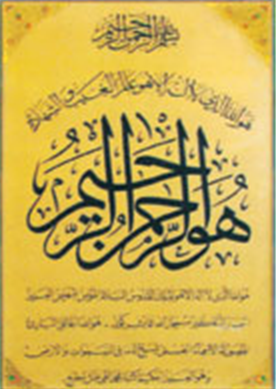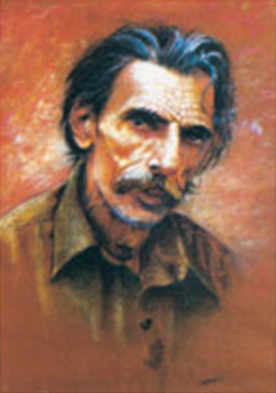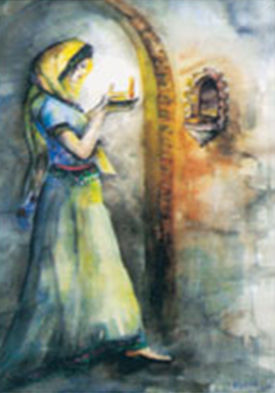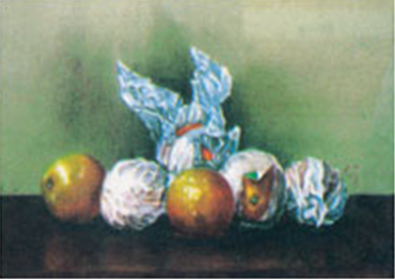Khyber Pakhtunkhwa: Art
This is a collection of articles archived for the excellence of their content. |
Frontier, Art
Art from the Frontier
By Marjorie Husain
Artists in Peshawar overcome numerous hurdles in their tenacious determination to uphold the traditions of their art. There has been significant artistic activity in the city since the emergence of the Abasin Arts Council, that celebrated fifty years of existence in 2006, and the establishment of the Department of Fine Arts, University of Peshawar in 1964.
S. S. Hyder was the first art instructor of the Abasin Arts Society and remained the heart and soul of all art activities there until his death in 1979. Still revered in the memories of the current generation of artists, many of whom were his former students, a national painting competition award has been established in S. S. Hyder’s name at an exhibition held biennially since 1981.
Shahzada Sultan Hyder was born in Ludhiana in 1922. After completing his formal education at the Aligarh Muslim High School, he joined the J. J. School of Art, Bombay, and upon graduation, joined his parents in Quetta where he set up a photographic studio and initiated classes in fine art. Hyder was a superb exponent of the New Bengal watercolour wash technique, as well as an acclaimed artist in the genres of portraiture and landscape using oil on canvas. He exhibited his work in Quetta and Karachi before settling in Peshawar in 1954.
It was fate inspired timing on his part. The then Commissioner of Peshawar, Mr Mussarat Hussain Zuberi, was a man interested in the arts and had established the Abasin Arts Society. He needed an artist with the attributes of expertise, talent and the gift of imparting his skills. Thus with the arrival of Hyder, the art society began in earnest.
Hyder loved to paint and he continued to create critically acclaimed work. A series of landscape paintings were shown in America and his work is found in the collections of art lovers throughout the world. He generously gave his work to friends and gifted five life-size paintings of the Quaid-e-Azam to the library hall of Peshawar University, where they still hang.
In recent months, the demise of S. Imtiaz Hussain, has been a great loss for the Peshawar art scene. Trained at NCA and teaching at NCA, Rawalpindi, Imtiaz was four times winner of the S.S. Hyder Award. Together with Jehanzeb Malik and Tayyaba Aziz Ahmed, he was the mainstay of art activities in the region. There is a great deal of talent in Peshawar as is seen when the artists invariably participate in the annual exhibitions of Punjab artists in Lahore. Their views of the historic terrain and cameos of life in the frontier are unique, so much so that in 2006, the work of S. Imtiaz Hussain and Jehanzeb Malik was displayed in an exhibition of landscape artists from Pakistan titled ‘Travels through Pakistan’ — shown at a popular art gallery in Frankfurt.
Jehanzeb Malik, the recipient of awards and prizes for painting and the promotion of art in the region was determined to carry on the tradition of holding the S. S. Hyder award, in spite of mourning the loss of his close friend. This he managed to do and the exhibition took place on 16th May, 2007 in Peshawar. It may be considered a tribute to S. S. Hyder and to S. Imtiaz Hussain, but Jehanzeb and his team faced almost insurmountable problems in their endeavour. Approval of the committee of the Peshawar Arts Council had to be sought and artists had to be contacted. Eventually paintings from many parts of the country were collected for display but in the meantime, the Culture Department closed the exhibition site for annual renovations, which are at present still underway.
Nevertheless, the preparations for the exhibition continued. Mansur Rahi and Hajra Zuberi were invited to Peshawar to judge the works along with Naseem Hukmat Khan and Nasiruddin Mohammad. The brochure and the invitation card were printed, and elicited a keen response. Sadly the violence in the province and the tragic bomb blast in Peshawar dampaned the optimistic expectations. Numerous guests tendered apologies for not attending the event.
By that time 160 entries has already been received and it was decided to hold the show as scheduled. When Jehanzeb inspected the exhibition site another shock was in store. There were 30 feet high ladders erected to paint the ceiling and bricks and rubble was spread all over the floor. In the centre of the room was a large stack of cement bags. After due meetings with the concerned in-charge, it was decided to make the hall available for a single evening event.
On the day of the show Jehanzeb with two assistants carrying nails, tools and strings, began to mount the canvases. They began at 11:30am and the work was completed a 5:00pm — just in time for the official opening at 6.30pm.
The gathering was sparse, much less than originally intended, but the contributing artists enjoyed the interaction and the opportunity to view their work in exhibition. Artists from Haripur, Lahore, Islamabad/ Rawalpindi, D. I. Khan, Quetta, Abbotabad and Peshawar, put up a show that would have greatly pleased S.S.Hyder with the diversity and handling of the media. In the words of an onlooker, ‘a variety of skills, design elements, and diverse techniques’ were on display. Three cash prizes were awarded in the categories of calligraphy, water-colour, oil, and mixed media. First prizes were accorded to M. Elahi Buksh Mutti for calligraphy; Tabassum Rizvi for her adept handling of oils, Istiaq Hussain for his sensitive portrait worked in mixed media, in the media of watercolours, Dr Ghulam Shabbier won the prize for painting a cityscape on a hot afternoon, softened and shaded by a densely leafed tree. It was a short lived but nonetheless memorable occasion.
All work had to be dismantled by 8:30pm that evening as the workmen were re-commencing work the next morning at 8:00am. Jehanzeb got busy dismounting the work, which the artists carried home. It was an admirable effort and one is filled with admiration for the spirit of art in this region, motivated by the undeniable talents of the artists bred by the rugged frontier.










